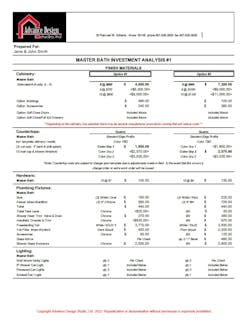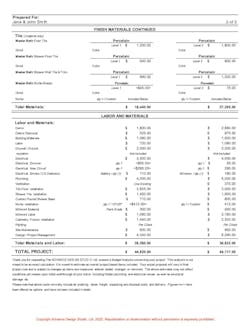The ability to estimate accurately is one of the cornerstones to success in remodeling. Many company owners learned the hard way that markup is not the same thing as margin, and if you’re going to use square foot pricing, you better know what you’re doing.
Estimating accurately is a universal must in the industry, yet methods are not universal. Many companies approach the process differently: In some cases, the company owner completes all estimates, while others may have a dedicated in-house estimator or a designer/salesperson in that role. One company may offer free estimates while another may not.
The bottom line is that there’s no one right way to estimate. Here, we spoke with three successful design-build companies to learn how they estimate a project.
RELATED: 3 Tips for Charging for Estimates
CQC Home
Durham, North Carolina
Employees: 25
Owner: Ken Combs
2021 Revenue: $13.5 million
The first step in estimating for Custom Quality Carpentry (CQC) Home is getting the client comfortable with a general budget scope. Owner Ken Combs calls it the pre-pre-estimate and says it’s about 20% accurate.
Combs uses the pre-pre-estimate when a prospective homeowner calls completely unaware of what their desired remodel costs are and is handled by a salesperson who references the proposed project scope, historic data, a square footage model, home value, location, and current pricing. Sales presents this general range to deliver on a homeowner’s needs through Pipedrive, a sales CRM.
Once that pre-pre-estimate is agreed upon, homeowners sign a design agreement that states the general scope is correct and they would like to move forward and get more specific.
The project then moves from sales to the estimating team, which works collaboratively with the design team for a preliminary design and more accurate pre-estimate, which falls into the pre-pre-estimate range.
“We give them a preliminary design and scope, and our estimating team puts numbers to those things in chunks that I would say are 80 to 85% accurate,” explains Combs. “At that point, we either reset expectations or it gives the client an opportunity to walk away.”
If the client agrees on the preliminary design and scope presented by the estimator, they pay 8% of the most recent estimate as a nonrefundable design fee. This pays for the estimator’s visit to the site, measuring, meeting with subs, determining material pricing with vendors, and working closely with design. During this process, the estimating team will reference historical data for anything priced less than $500, but anything more will be quoted from the sub. The full estimate is then created by line item within CoConstruct.
The final numbers are fixed prices with all materials selected, with one recent caveat: a recently added escalation clause. The clause covers material changes up to 5% higher than the estimate, and clients must pay the difference if it exceeds or CQC will reimburse if it comes under.
“You want to make sure clients understand things are evolving and prices are going up, and the reality is that prices are not going down on anything,” says Combs.
Combs advises achieving 100% accuracy for estimates without “fluff.” Never make adjustments for additional project management hours or travel time, for example, or else your historical data will never be accurate when you reference back, he explains.
Advance Design Studio
Gilberts, Illinois
Employees: 35
Owners: Todd and Christine Jurs
Revenue: $10.3 million
Advance Design Studio (ADS) refrains from sending estimates, rather, it sends a “investment analysis.” The approach aligns with the company’s tagline, “Common Sense Remodeling” and its goal to set up a baseline of trust with the client.
This analysis comes from historical job costs and an initial consultation with the homeowner and a designer salesperson. Depending on the scope of the project, a project manager may also be present and advise subcontractors on pricing.
The analysis is then given to the homeowner in a range, similar to CQC’s approach, but it’s expanded into multiple options in a good-better-best format with different price ranges.
“Let's say we're working in a bathroom. We probably will have a chrome package in the first column versus a brushed nickel or oil rubbed bronze or matte black in the second column,” explains Claudia Pop, managing director of sales and lead designer. “It gives the homeowner control over their bottom line and helps them pick and choose the items that are important for them.”
An example investment analysis by Advance Design Group.
This complimentary estimate puts the conversation on paper, setting up a range that the client would be comfortable moving forward with material selection and design. Pop says offering free estimates is justified because much of the client vetting is done before initial conversations happen between the designer and homeowner. About half of the clients who receive the free estimate move forward with the project.
Pop says these analyses are 90 to 95% accurate. Once the customer agrees, a design retainer is received and the ADS team works toward bringing the cost into one of the proposed columns.
“The financial analysis range that we start with is a live document,” says Pop. “As we're making selections, those columns will eventually merge into one.”
RELATED: Why We Hired an In-House Estimator
Simply Home
Austin, Texas
Employees: 12
Owner: Ashley Wainscott
2021 Revenue: $3.3 million
Before settling on the current estimating process, Simply Home battled inaccurate pre-estimates. Company officials found that the process missed a crucial step: thorough job comparisons.
If a potential client is inquiring, a salesperson will conduct a 15-minute call to understand the project and introduce the homeowner to Simply Home’s process. If both the project and company align, the salesperson requests scopes, pictures, descriptions, and a budget to create a ballpark estimate based on previous job costs documented in Buildertrend.
“The reason we do broad and not go smaller scale at this stage is because A: we're feeling them out and if this broad range is even something that's doable,” explains Senior Project Manager Michelle Mullins. “And B: what we've learned is we don't want them to price shop us. And we don't want them to take our bid and go see if someone can do it cheaper for that."
Once the ballpark and homeowner are aligned, the next step is a 5% down payment based on the ballpark estimate, which pays for a site visit with appropriate subs and goes towards the final estimated cost. A final detailed estimate is then created based on vendor visits, measurements, and all the dirty details.
Previously, Simply Home found their ballpark estimates were significantly off from the new estimate created post-site visit. And after putting the time into gathering vendors and project managers for that site visit, without a down payment, Simply Home saw clients were not locked down.
Mullins likes to joke with homeowners about the 700-page estimate they receive but emphasizes it’s important to detail each cost for transparency. Estimates detail each product and material, along with its location and other specifications so each detail a client pays for is accounted for.
“It's a lot, but we want it to be a lot for a reason because we want to show the client that we are committed to them, and that we're going to make the time for them,” explains Mullins.



